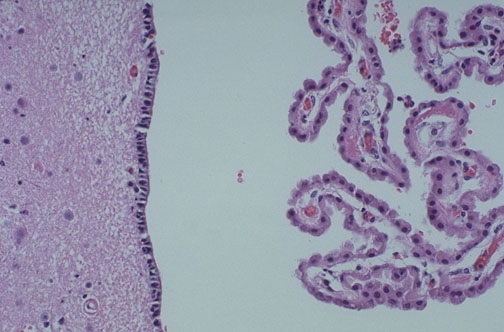Cerebrospinal Fluid (CSF)
PKGhatak, MD
The previously held view of the formation and circulation of the cerebrospinal fluid (CSF) has undergone modifications because current reproducible and non-interventional methods of investigation, like MRI and molecular and biological biology, discovered newer facts that contradicted the past theory.
To update the current thinking, a brief review of the histology of the Choroid plexus, Ventricles of the brain and Arachnoid granulations is necessary.
Choroid plexus.
The Ependymal cells of the choroid plexus secrete the CSF by an active process. The central capillary of the choroid plexus is lined with one layer of fenestrated cuboidal cells. The albumin content of CSF is much lower than plasma. The transport of water across the ependymal cells of the carotid plexus is carried out by separate transport proteins, one for the ventricular side and the other for the capillary side. It is an active process that requires energy from ATP and likely also from K / Cl transporter. About 30 % of the total water volume of CSF comes from the inter-neuronal space, generated from the metabolic activities of the nerve cells, like Lymph formation in the other organs. There are to and fro moments of fluid between interstitial fluid and CSF.
Blood Brain Barrier.
This special characteristic of the blood vessels of the brain is due to the tight seal between the endothelial cells of the capillaries and supplemented by perivascular feet of astrocytes surround the basement membrane. In two locations this barrier is absent namely the choroid plexus and posterior pituitary gland.
Arachnoid Granulation:
Arachnoid granulations are collections of capillary networks kept suspended into the large veins of the subarachnoid space. The anatomical structure suggests arachnoid granulations are filters - a one way passage of CSF into the venous blood, getting rid of waste products and excess water. But that is not the case. Arachnoid granulation plays a minor role in this respect.
The perineural space along the cranial nerves and spinal nerves and the perivascular space known as Virchow Robin spaces are the main routes of drainage and filter of CSF into the general lymphatic system. This is specially evident in the Olfactory nerve as it travels through the cribriform plate of the nose.
Circulation of CSF:
The circulation of CSF in the brain and spinal cord.
The circulation of the CSF is an active process by the synchronous motion of cilia lining the surface of the ventricles and the central canal of the spinal cord. The CSF exits the brain through two openings of Luschka in the hindbrain and circulates in the subarachnoid space. The mechanism of a steady state of CSF formation, circulation and drainage has undergone many modifications. The circulation is pulsatile in nature due to and from movement of the CSF. The interstitial fluid exchange with CSF is a major component of circulation. A continuous bidirectional fluid exchange at the blood brain barrier produces flow rates. The general lymphatic system of the body is the main route of drainage of waste products of the brain and an entry point of the immune system in the brain.
******************************





No comments:
Post a Comment